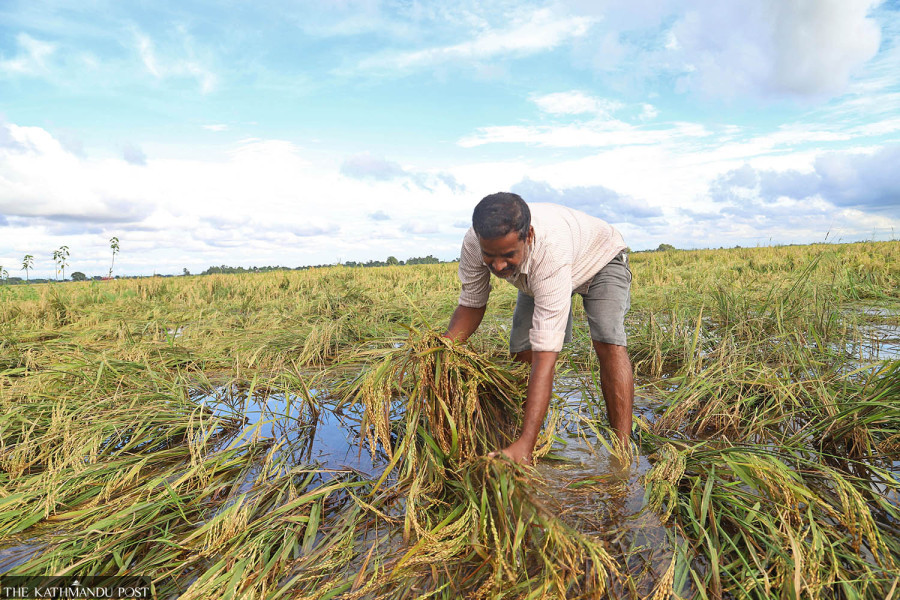Climate & Environment
Several Tarai districts witness below-average monsoon rainfall
With only 60 percent of land cultivated so far, locals from areas affected by severe dry spells are worried about a food crisis.
Post Report
Monsoon is likely to end by the next three weeks but farmers from Dhanusha have cultivated only around 60 percent of their lands so far. A lack of sufficient rainfall in the district has not only deprived farmers of cultivating all arable lands but also timely cultivation, which would eventually affect the production of food crops.
“We have not yet estimated the loss farmers would incur due to the below-average rainfall and delayed monsoon, but so many of them have been worried about hunger,” said Sangita Kumari Jha, chief of the Agriculture Section at the Lakshminiya Rural Municipality, Dhanusha.
“Farmers have complained to us about dry rice fields. The light rainfall happening occasionally does not soak the fields properly. They are worried about what to eat for the rest of the year.”
Dhanusha is one of the districts in the Tarai, a region called the food basket of Nepal. According to the Department of Hydrology and Meteorology, Janakpur, Dhanusha has witnessed only 50 percent of the monsoon rainfall so far this year.
Banke, Dang, Kailali, Kapilvastu and Bara are other districts of Tarai region that have been witnessing below-average monsoon rainfall.
Dhanusha has witnessed only about 50 percent of the monsoon rainfall, according to Sudarshan Humagain, a meteorologist at the department. “Several other districts in the region have also witnessed below average monsoon rains as of now.”
Like most farmers in Nepal, those in the aforementioned districts depend heavily on rainfall to cultivate their crops due to the lack of an irrigation system. And rice cultivation needs abundant water. A below-average rainfall in these areas this year will certainly affect the production of food crops, experts say.
“Monsoon started too late this year in our province [Madhesh],” said Kabita Bista, chief of the Agriculture Section at the Aurahi Municipality of Mahottari district. “We have held rounds of meetings with chief district officers and other concerned agencies about declaring drought-hit areas.”
Nepal has been at the receiving end of the worst effects of the climate crisis and has witnessed multiple extreme weather events over the past decade and a half.
Evidence suggests that the maximum temperature in Nepal is rising faster, at 0.056 degrees Celsius a year, compared to the global average of a rise of 0.03 degrees Celsius a year.
Experts say extreme weather events—excessive rainfall in a short time, continuous rain for several days post-monsoon, dry spells and droughts, below-average precipitation and above-normal temperatures in winter—have become more frequent in Nepal in recent years.
Scores of studies and scientific analyses over the decade, and more recently, the IPCC report have warned that Nepal is one of the most vulnerable countries to climate change and it takes more than a business-as-usual approach to tackle the adverse impacts of the climate crisis.
Last year too, districts of western Tarai, including Banke, witnessed drought during the entire monsoon season and freak rains post-monsoon inundated farmlands that forced hundreds of people to cross the border in search of livelihood opportunities.
Climate scientists say the concerned authorities are too slow to take measures to address the problems caused by erratic weather events.
“Our prime minister is attending the United Nations General Assembly this month and is likely to make some new commitments on climate change-related issues,” said Raju Pandit Chhetri, an environment and climate change expert. “While making new commitments before the international community, we should also pay attention to implementing our previous pledges.”
Prime Minister Pushpa Kamal Dahal is set to address the 78th session of the United Nations General Assembly on September 21.
Farmers in western Nepal affected by flood and drought are yet to receive the compensation amount declared by the government about two years ago.
“We will estimate the loss incurred in the agriculture sector once all the farmers harvest their crops,” said Jha, chief of the Agriculture Section at the Lakshminiya Rural Municipality, Dhanusha. “Then we will send a report to the provincial authority.”




 10.12°C Kathmandu
10.12°C Kathmandu










